SEAT
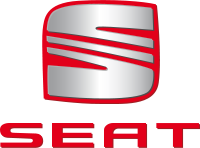 |
|
| Type | Private company, Subsidiary of Volkswagen Group, member of the Audi Brand Group |
|---|---|
| Industry | Automotive |
| Founded | May 9th 1950 |
| Founder(s) | Instituto Nacional de Industria |
| Headquarters | Martorell, Spain |
| Number of locations | Martorell, Spain Zona Franca, Spain Prat, Spain |
| Area served | Europe, Africa, Central America, South America, Middle East, Asia |
| Key people | James Muir Chairman of SEAT’s Executive Committee Luc Donckerwolke SEAT Design Director |
| Products | Cars |
| Services | design, manufacture and distribution of SEAT and other Volkswagen Group cars and components |
| Employees | 11,010 (2008) |
| Parent | Volkswagen Group |
| Divisions | SEAT Sport |
| Website | SEAT.com |
SEAT, S.A. (English pronunciation: /ˈseɪ.æt/ "say-at"; Spanish: [ˈse.at]) is a Spanish automobile manufacturer founded on May 9, 1950 by the Instituto Nacional de Industria (INI) of Spain, currently being a wholly owned subsidiary of the German Volkswagen Group [2] as a member of the Audi Brand Group, together with Audi and Lamborghini [3][4], and marketed as a car maker with a youthful sporty profile [5][6]. Within the Volkswagen Group and under the Audi Brand Group, the SEAT brand itself is developed as a group with subsidiary companies ( SEAT Group ) and 'SEAT, S.A.' as the parent company [7].
The headquarters of SEAT, S.A. are located at SEAT's industrial complex in Martorell near Barcelona, Spain. By 2006 annual production was over 400,000 units; in total, over 16 million cars have been produced [8] including more than 6 million from the Martorell plant [4], with two thirds of the annual production being exported to over seventy countries worldwide [9].
The name SEAT, previously standing for the acronym Sociedad Española de Automóviles de Turismo (Spanish Touring Car Company, in English), in 1990 was changed to SEAT, S.A. [4].
Contents |
Facilities
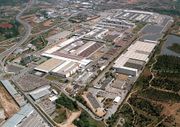
SEAT today is the only major Spanish car manufacturer with the ability and the infrastructures to develop its own cars in-house [10].
Its headquarters and main manufacturing facilities are located in Martorell, an industrial town located some 30 kilometres north-west of Barcelona [11], with a production capacity of around 500,000 units per annum [12]. The plant was opened by King Juan Carlos of Spain on February 22, 1993, and replaced SEAT's former assembly plant by the coast in Barcelona's freeport zone. A rail transport between SEAT's Martorell complex and Zona Franca facility makes the connection with the port of Barcelona in the aim of vehicle and spare parts transportation [13].
The industrial complex in Martorell also hosts the facilities of SEAT Sport [14], SEAT's Technical Center, Research and Development Center (R&D) [15], Design Center [16], Prototypes Centre of Development [17], SEAT Service Center (also incorporating the After-Sales Service division, the Customer Services division and the Catalunya Motor dealership) [18], as well as the Genuine Parts Centre for SEAT, Volkswagen, Audi and Škoda brands [19]. The development and assembly facilities are some of the newest and most modern within the Volkswagen Group, giving the owned by SEAT Martorell site the ability, in terms of efficiency and high-quality [20], to produce cars not only for its own range but also for other Volkswagen Group brands, such as Volkswagen and Audi marques [21]. For example, the development and design of the Audi Q7 took place there, and from 2011 onwards the Martorell plant shall take over the production of the upcoming Audi Q3 small SUV [22].
The Barcelona 'Zona Franca' site hosting the SEAT Training centre [23] as well as the Zona Franca Press Shop factory producing stamped body parts, and the Barcelona Gearbox del Prat plant producing gearboxes not only for SEAT but also for other Volkswagen Group marques (VW, Audi and Škoda) [24], are both production facilities owned by SEAT, S.A, with the latter plant being awarded in 2009 by the Volkswagen Group for high-quality production process and product with the Volkswagen Excellence Award [24]. Another plant that was in the past a property belonging directly to SEAT since 1975 [25] was the Landaben plant in Pamplona, but in 1994 the ownership was transferred to the Volkswagen Group subsidiary 'Volkswagen Navarra, S.A.' and the site today is producing Volkswagen cars in Spain [26]. However, SEAT's Martorell site still provides support to the Volkswagen's operations in the Pamplona plant when necessary, as it did for example after a serious fire which occurred in the paint shop in the Landaben VW plant in April 2007 [27].
Factories of the Volkswagen Group currently producing SEAT models also include the Palmela AutoEuropa site in Portugal [4], while in the past other plants were involved too in producing SEAT models, such as the factories in Germany (Wolfsburg), Belgium (Brussels) and Slovakia (Bratislava) [28]. Future plans include a new Research and development (R&D) centre in the city of Barcelona in the field of environmental and energy efficiency for the entire Volkswagen Group and also the launch of a project on the city's urban mobility [29].
Among SEAT's subsidiaries, the 'SEAT Deutschland GmbH' subsidiary company is based in Mörfelden-Walldorf (Germany), and apart from its commercial activities has the further responsibility of operating SEAT's electronic platform, i.e. the 'SEAT IT Services Network' [30]. In Wolfsburg (Germany) inside the Autostadt [31], the Volkswagen Group's corporate theme park located next to the Volkswagen's factory, lies also open to visitors in the middle of a lake the SEAT's thematic Pavilion, as one of the largest pavilions in the park [32].
Awards
All over the years the SEAT marque has been honoured with several awards, such as
- The Barcelona 'Gearbox del Prat' plant, 100% owned by SEAT, S.A. , received in 2009 the Volkswagen Excellence award for its high-quality manufacturing process and product [24].
- The SEAT brand itself in 2009 has been named 'Most Improved Used Car Brand of the decade' in the CAP Used Car of the Decade Awards [33][34].
- 'AvD Innovationspreis 2006' award for technological innovations developed at the SEAT Technical Centre in Martorell, from the German automobile club 'Automobilclub von Deutschland' (AvD) [35]
- In the 2007 Barcelona International motor show SEAT received two awards for the best technological innovations in the automotive sector, for the LED modules implementation in headlights and the project of virtual fabrication and applied ergonomics.[36][37]
- 'Best project in the use of an electronic signature in the private sector in 2008' for SEAT’s electronic invoicing system, by the Catalan Certification Agency (CATCert) [38]
- 'Best logistics initiative 2007' award for the SEAT-Autometro project, by the International Logistics Salon [39]
- 'Port of Barcelona’s Distinguished Loader prize in 2008' , by the Port of Barcelona’s Loaders’ Association [40]
Presence in different markets
The company styles its own models of cars in accordance with the development policies of the Volkswagen Group. Some of its cars have been sold outside Europe, badged as Volkswagens, such as the SEAT Ibiza hatchback, known in South Africa as the Volkswagen Polo Playa, the SEAT Inca panel van as the Volkswagen Caddy, or the SEAT Córdoba also known as the Volkswagen Polo Classic.
Rumours of a SEAT model being sold as a Volkswagen in Canada and the United States to supplement the Volkswagen's brand lineup there have occasionally circulated, but have always been unsubstantiated, and ultimately proven to be false. SEAT markets 6 models in Mexico, and has dealer presence in 27 Mexican states.[41]
SEAT maintained a limited market presence in Trinidad and Tobago between 1992 and 2004. Local dealership, H.E Robinson Ltd. was also the importer for Rover and Proton cars. The first SEAT model sold in Trinidad was the Terra LCV . Later introductions included the Ibiza and Cordoba . The Ibiza 2.0GTI was dominant on the local rally circuits for a short time. A brave attempt at rivaling other European brands was initiated in 1999 with the introduction of the Alhambra minivan, Toledo sport saloon and Arosa supermini. The poor backup service provided by the dealer and the subsequent bankruptcy of H.E Robinson Ltd. in 2002, sorely damaged the SEAT brand in Trinidad and Tobago. SEAT continued to be sold by Trinidad and Tobago Autos Ltd, which had assumed the old dealership's Rover franchise. As a result of limited sales , SEAT was finally pulled from the market in late 2004.
SEAT's presence in international markets (outside of Europe) has yet to be realised, with the failed plan to launch SEAT in Canada in 1994, and with the withdrawing of SEAT from the Australian market after only selling its range from 1995–1999 and a total of 3,600 vehicles in the 4 years it was on the Australian market. Following SEAT's departure from Australia, unsold Cordobas ended up in New Zealand, where they were sold until 2001. SEAT is also positioned to launch in the United States sometime after 2008, although this has yet to be verified as a certainty. SEAT currently continues to expand to international markets under the Volkswagen Group, particularly in the Middle East and Asia, achieving a considerable success in Thailand, China, Jordan and Israel. After launching the brand in South Africa in June 2006 & selling approximately 2600 vehicles, Volkswagen South Africa announced that it's pulling the SEAT brand from the country by end 2008, citing that current and expected circumstances make the ongoing importation of a niche brand in the South African market non-viable.[42][43]
History
Partnership with Fiat
SEAT was founded on May 9, 1950 under the name 'Sociedad Española de Automóviles de Turismo, S.A.' by the Instituto Nacional de Industria (INI) with a capital of 600 million Pesetas, almost a year and a half after the Spanish government and five Spanish banks[44] had signed on October 26, 1948 an alliance contract with the Italian car manufacturer Fiat [45]. Initially, SEAT manufactured rebadged Fiat models which differed very little visually from the products of the Italian firm. The SEAT 600, based on Fiat 600, was the first car for many Spanish families, and became a symbol of the Spanish Miracle. The SEAT Panda (later restyled as SEAT Marbella) for example was based on the Fiat Panda.
By 1967 SEAT was Spain's largest auto-maker. In that year Fiat increased its holding in the company from 6% to 36%. At the same time the share held by the government holding agency was reduced from a controlling 51% to 32%. The remaining 32% was taken by six major banks. Although not a majority owner, Fiat now was seen to control the business: the deal also included various undertakings by Fiat to help in the growth of SEAT, and with the development of a new model (possibly the SEAT 133).[46]
During the ensuing period, the manufacturer continued to dominate the Spanish auto market, producing 282,698 cars - more than 58% of the Spanish production total - in 1971 despite disruption that year caused by strikes and a serious flood at the coastally sited Barcelona plant.[47] However, with just 81 cars per thousand people, Spanish car sales were seen as ripe for further growth, and SEAT faced the prospect of increased competition with other major manufacturers contemplating establishment or expansion of 'local' production facilities in the still heavily protected Spanish car market[47].
The 1970s were a decade of rising prosperity in Spain, which is reflected in the announcement in August 1976 that SEAT would commence local production of the Lancia Beta.[48] Three years later Beta production by SEAT indeed commenced at the company's recently acquired Pamplona plant, though only the Coupe and HPE lift-back versions were included. The Spanish cars were fitted with a simplified suspension system and smaller engines than their Italian counterparts in order to qualify for a lower car tax rate.
In the early 1980s extensive discussions concerning funding and control took place between the major share holder, the Spanish government, and Fiat: SEAT needed major capital investment which Fiat was not prepared to inject. The outcome, by 1982, was an end after nearly 30 years, to the relationship with Fiat. The first car under the new SEAT logo without Fiat involvement appeared in 1982, and was called the SEAT Ronda. This was a restyled Fiat Ritmo, and sparked a lawsuit from Fiat against SEAT, as the former claimed the car was still too similar to the Ritmo. The then president of SEAT, Juan Miguel Antoñanzas, showed a Ronda to the press with all the parts different from the Fiat Ritmo painted in bright yellow, to highlight the differences. This ended the dispute. Rumour at the time had it that Fiat was angry because the Ronda restyling was in fact too close to their own planned restyling for the Fiat Ritmo, which they had to scrap.
Volkswagen Group subsidiary
A year after the withdrawal of Fiat in 1981, the Volkswagen Group signed on September 30, 1982 a cooperation as well as a licence agreement with SEAT for the production of the Volkswagen Passat, Santana and Polo models in Spain. On June 18, 1986 after a purchase of SEAT's 51% majority stake followed later that year by the increase of its share up to 75%, the Volkswagen Group became the major shareholder of SEAT, and as of 1990 the 100% owner of the company.
Environmental policy
'Ecomotive' range
Almost every model in SEAT's range has an 'Ecomotive' derivative version, which in comparison to the standard version has a more eco-friendly tuning [49]. Reduction of weight, low-resistance tyres, new aerodynamics, tweaks in the suspension [50], as well as changes made to the engine's electronic management software with an additional implementation of a maintenance-free[51] Diesel Particle Filter (DPF) for the diesel engines, also updates in the gearbox and the gear ratios with a gearshift indicator in the dash panel reminding when it is the proper time to change gears, combined with an engine 'Start/Stop system' and an 'Energy Recuperation system' are some of the modifications adopted in the Ecomotive range in order to cut down both fuel consumption and emissions [52]. The result is a range with some of the cleanest models [53] featuring an improvement not only in gas and particles emissions but also in fuel economy, without big compromise in the vehicle's dynamic performance or practicality; for example the SEAT Ibiza Ecomotive 1.4 TDI has CO2 emissions coming up at 98 g/km [54] and still it comes even faster from 0 to 100 km/h than the standard version [55] featuring a 5-door body and air-conditioning , while the SEAT León Ecomotive's CO2 emissions are among the lowest in its segment too and raise up to 99 g/km [56]. Up to the present, the Ecomotive range has been renowned in many occasions. In 2008, the Ibiza Ecomotive has been declared on top of the Verkehrs-Club Deutschland’s 2008/2009 list in the “environmentally beneficial vehicle” category [57] and in the 10th Eco Tour not only it has won in the small diesel class but also proved to be the overall winner of all categories [58]. In that specific year the SEAT Ibiza Ecomotive was also awarded with the 'Ecobest 2008' award by the Autobest organisation [54] and the German newspaper Bild am Sonntag named it the 'most economic car of its class in the world' [59]. The year 2009 has been the one when once more the Ibiza Ecomotive was nominated for the 'Green Steering wheel' award in Switzerland [60], and has set two consecutive times a new world record on fuel saving with a single tank, certified by the IPMC (International Police Motor Corporation) : the first when the Austrian Gerhard Plattner drove from Martorell (Spain) to Göttingen (Germany) with an average fuel consumption of 2.9 l/100 km [61] and the second time in his route from Cieszyn (Poland) to Frankfurt (Germany) having achieved the world record in fuel consumption of 2,34 /100 km (or 100 mpg U.S.[62]) covering a distance of 1,910 km on a single tank [63].
'MultiFuel' range
The MultiFuel range consists in the introduction of the flexible-fuel vehicle bio-ethanol technology in selected SEAT models - i.e. the SEAT León MultiFuel [64], the SEAT Altea MultiFuel [65] and the SEAT Altea XL MultiFuel [66] - with the implementation of the 1.6 MPI MultiFuel E85 motor, capable of producing exactly the same horsepower (102 bhp) just like the relevant pure petrol version of the engine.
‘SEAT al Sol’ project
The ‘SEAT al Sol’ project consists in the integration of use of solar power through a system of photovoltaic panels generating electricity in SEAT's factory in Martorell. The project is going to be carried through in collaboration with GA-Solar from the beginnings of 2010, covering a factory area of 320,000 m2 with a system of more than 10 MW of photovoltaic panels. This installation is expected to produce more than 13 million kwh of electricity annually, aimed at reducing greenhouse gas emissions by over 6,200 tonnes of CO2 per year.[67][68]
'Cenit verde' project
The Cenit VERDE initiative is a research project backed by the CENIT (the National Strategic Consortia for Technical Research) programme and supported by the Spanish Ministry of Science and Innovation, in which SEAT plays a key role. Aiming at developing technologies, components and infrastructure for hybrid and electrically-powered cars in Spain, this programme brings together 16 technology companies (including Siemens, Endesa, Iberdrola, REE, Cegasa, Ficosa, Circuitor, Cobra or Lear) and 16 universities and research establishments under the CTM coordination (Centre Tecnològic in Manresa) [69] and the support of the CDTI (Centre for Industrial Technological Development, an organization pertaining to the Ministry of Science and Innovation) .
In January 2010, the Cenit Verde association made its opening meeting at SEAT's Technical Centre in Martorell [70].
As part of its contribution SEAT comes in with its own 'Verde' pre-project, including the technology implemented in the plug-in hybrid SEAT León Twin drive [71] as well as in the SEAT IBE concept zero emissions electric vehicle presented in the 2010 Geneva motor show [72].
'SEAT Autometro' project
The 'SEAT Autometro' project comprises the construction and management of a rail link service between the SEAT's Martorell complex and the Port of Barcelona, in the aim of transport of vehicles and components. Autometro is the joint-venture company which operates the rail, having Ferrocarrils de la Generalitat de Catalunya (FGC) local rail company, COMSA Rail Transport and Pecovasa as its shareholders. The company was founded in November 2005 almost five months after an initial agreement was signed between the Catalan government (Generalitat), the Barcelona Port Authority and SEAT [73]. Due to this project, a branch connecting the Martorell plant with the FGC 'Llobregat-Anoia' main rail line had to be constructed, as well as further adaptations to the transport network and the host infrastructures in the Port of Barcelona had to be made. The budget for the project comes up to 6.8 million euro, while SEAT on its part also assumes the operational transport costs [74].
The use of this rail link since January 18, 2008, instead of road transport, has helped not only in terms of cost effectiveness and road safety but also in the reduction of both road congestion and greenhouse gas emissions.
Over the whole 'Autometro' project awards have been given for the best logistics idea at the 2007 International Logistics Fair (SIL) and specifically to SEAT as the 2008 Distinguished loader by the Loaders’ Association of the Port of Barcelona.[75]
SEAT in motorsport
SEAT's involvement in motorsport begins back in the '60s with the brand's contribution to the national formula races in Spain and by the end of the same decade the start of its implication to rallies [76]. In 1971, the 'Special Vehicles department' was formed with the mission to enforce the brand's participation in rally championships, followed by 11 titles between 1979 and 1983 [77]. The year 1985 was the moment when SEAT Sport was founded as a separate motorsport division and especially since the Volkswagen Group takeover in 1986, SEAT has been increasing even more its presence in the motorsport world, mainly down to VW's plan on focusing the SEAT brand as 'sporty' in order to appeal particularly to the younger generation of drivers[78]. The result of this effort has been rewarded through SEAT's most prestigious titles in FIA championships, three conquests with the SEAT Ibiza Kit-Car in the FIA 2L World Rally Championship (WRC) (1996, 1997, 1998) and two times with the SEAT León in the FIA World Touring Car Championship (WTCC) (2008, 2009) [79].
Rallying
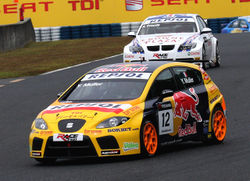
SEAT's first serious attempt at a World Rally Championship (WRC) title was burdened on the small SEAT Ibiza, a 1.6L normally aspirated front-wheel drive car with its roots in the Volkswagen Polo. The Ibiza allowed the company to start building its rallying experience, and was officially engaged in some European national championships. The years went by and little success followed until a 2L version of the Ibiza was homologated as a kit-car, and extra wide tracks, larger wheels, brakes, etc., were fitted to it as the Fédération Internationale de l'Automobile (FIA) kit-car regulations allow. With these attributes, the car succeeded three times the 2L World Champion ('96, '97, '98), proving its maker had accumulated enough experience, and budgets, to take a chance at the reign category, the World Rally Car class of rallying cars.
SEATs three conquests of the 2L FIA title, and the sport's popularity in Spain, probably convinced Volkswagen Group management to go further, and allocate sufficient budgets to the SEAT Sport department so as to allow it a chance to reach its goal. This situation came to an end in September 2000, when the company's, German upper management revoked its decision, and budgets, forcing SEAT Sport to retire from the World Rally Championship. The absence of convincing results must have obviously helped the management's decision.
SEATs project to build a WRC-spec car was officially announced during the 1997 San Remo rally. It was in 1998 that the SEAT Córdoba WRC was first enrolled by the company to compete at the highest level of WRC racing. The Córdoba was based on the family saloon of the same name but was, naturally, a WRC class car. It had a 4 cylinder turbocharged petrol engine, permanent four-wheel drive, and active differentials were involved in its transmission. However, the short wheelbase and high-mounted engine (compared to its rivals) worked against the Córdoba, and results weren't impressive. Despite hiring ex-WRC champion Didier Auriol, and a new evolution of the car, SEAT pulled out of international rallying at the end of 2000.
Touring cars
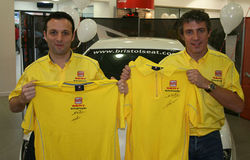
In 2002, SEAT announced a one-make championship for the new SEAT León Cupra R, the SEAT León Supercopa.
In 2004, SEAT with Ray Mallock Ltd. (RML) entered the British Touring Car Championship, running two SEAT Toledo Cupra for former-BTCC Champion Jason Plato, and 2003 León UK Champion, Rob Huff. In 2005, Huff left to join Chevrolet (run by RML in the World Touring Car Championship (WTCC), and he was replaced by 2004 Leon Champion James Pickford, and Luke Hines as SEAT expanded to three cars, now run by Northern South. 2006 saw the Toledo replaced by the new León, and Darren Turner joined the team with James Thompson when his WTCC commitments allowed. 2007 was SEAT's best year in BTCC, as Plato was locked in a season-long battle with Fabrizio Giovanardi, which came down to the final race of the season, but just missed out on the title.
Since 2005, SEAT has also competed in the World Touring Car Championship, with its first best season being 2007, where a failed water pump robbed Yvan Muller of certain victory at the final meeting in Macau. SEAT utilised Audi's pioneering diesel engine technology (from the Audi R10 TDI LMP1) in touring cars, when they became the first team to run a TDI in the WTCC. This gave them a dominant 2008 World Touring Car Championship season, with Yvan Muller wining the driveras championship. French racing team Oreca cooperates with the WTCC team. SEAT's UK team followed suit in the 2008 BTCC. The BTCC team was sponsored by Holiday Inn.
On the 11th September 2008 SEAT UK announced that it was to withdraw from all motor sport activity in the UK at the end of the season. The SEAT Cupra Championship and the SEAT BTCC campaign are to end at Brands Hatch on the 21st September. BTCC drivers Jason Plato and Darren Turner have been left without drives for 2009. But Plato will drive for Silverline Chevrolet.
At the opening of the 2009 WTCC, SEAT placed 1st, 2nd, 3rd, and 4th in both races in Brazil.[80] At the second meeting of the WTCC (in Mexico), the SEAT team placed 1st, 4th, 6th, 7th and 11th in the first race. The second race they placed 1st, 3rd, 7th, and 8th.[81] While SEAT may have withdrawn from the BTCC, they are showing impressive results in the WTCC.
Sponsorship
SEAT has been a sponsor in major sports events, such as
- UEFA Europa League [82]
- Red Bull Air Race World Championship [83]
- Davis Cup World Group Final [84]
- Barcelona 1992 Olympic games [85][86]
and a strong supporter to artists, like Shakira[87], Armin van Buuren[88], David Guetta[89][90] etc.
Model range
Nomenclature
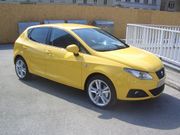
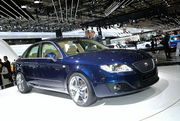
SEAT's corporate tradition, as a Volkswagen Group subsidiary, has it that the nomenclature for a great number of models in its range gets inspired from the Spanish culture. For this purpose, a large number of SEAT's production models have been named after cities of Spain (e.g. Arosa, Ibiza, Córdoba, León, Toledo, Altea, Alhambra, Inca, Marbella, Ronda etc.) [91]. However there have been several cases where the denomination for a specific model did not derive directly from the Spanish heritage of the marque. As an example given making this exception, the name for the SEAT Exeo - the most recently added model to the brand's range - was influenced from the Latin word ‘exire’ which means 'to go beyond' [92].
Following the marque's trend in production models, in many cases of concept cars too the names adopted were those either of Spanish dances (e.g. Tango, Bolero, Salsa) or acronyms still related to production models (e.g. IBZ for Ibiza, IBE for 'Ibiza Eléctrico'[93], TL for Toledo etc.) or even names reminiscent of SEAT's sporting roots in the past [79] (e.g. Fórmula, Cupra GT) .
Moreover in the recent years, there have been special versions in the production models' specific ranges carrying attachments such as SC (standing for SportCoupé [94]) or ST (for SportTourer [95]) discriminating relatively the 3-door and the estate versions from the standard 4/5-door ones, while the terms Cupra (for Cup Racing [96]) and FR (for Fórmula Racing [97]) have been used for the top-engine hardcore cars in the range, signalising SEAT's positioning as a sporty brand[6] involved in the racetracks.
As a reminder from the past also comes the iconic 'Bocanegra' name, meaning 'black mouth' in Spanish, which accompanies the Ibiza model and has its origins in the SEAT 1200 Sport, the original 'SEAT Bocanegra' due to its black painted fascia in the front [98].
Current models
- Ibiza / Ibiza SC / Ibiza ST
- León
- Altea / Altea XL / Altea Freetrack
- Exeo / Exeo ST
- Alhambra
Earlier models
|
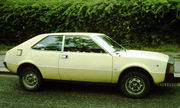
SEAT 1200 Sport, 'Bocanegra'
|
Concept models
|
Notes
- ↑ SEAT.com - legal note
- ↑ "> 1979-1950". SEAT.com. http://www.seat.com/com/generator/su/com/SEAT/site/company/history/1979-1950/main.html. Retrieved 2010-03-09.
- ↑ Audi Brand Group http://www.volkswagenag.com/vwag/gb2006/content/en/Divisions/Audi_Brand_Group.html
- ↑ 4.0 4.1 4.2 4.3 "SEAT hoy". Media.seat.com. 2009-03-23. http://media.seat.com/en/company/368-seat-hoy.html. Retrieved 2010-03-11.
- ↑ SEAT celebrates 60 years http://media.seat.com/en/company/60th-anniversary/609-seat-cumple-60-anos.html
- ↑ 6.0 6.1 SEAT is the youthful and sporty car maker from Spain http://media.seat.com/en/seat-news/597-nuevo-seat-alhambra-mas-funcional-y-eficiente.html
- ↑ SEAT Annual report 2008 http://www.volkswagenag.com/vwag/vwcorp/info_center/en/publications/2009/03/Seat_Annual_Report_2008.-bin.acq/qual-BinaryStorageItem.Single.File/Seat_AnnualReport2008.pdf
- ↑ "SEAT produces car number 16 million since its beginnings". Media.seat.com. 2008-01-25. http://media.seat.com/en/seat-news/2008/65-seat-produce-el-coche-numero-16000000-de-su-historia.html. Retrieved 2010-03-08.
- ↑ SEAT facts http://www.seat.com/com/generator/su/com/SEAT/site/company/facts/main,lang=es.html
- ↑ SEAT facts http://www.seat.com/com/generator/su/com/SEAT/site/company/facts/main.html
- ↑ Martorell plant 15-years of activity celebrations http://media.seat.com/en/seat-news/2005/238.html
- ↑ Viaintermedia. "PV solar - your source for renewable energy news– solar, wind, biomass, biofuel, hydro, CO2, solar thermal, hydro power, climate change, carbon trading". Renewable Energy Magazine. http://www.renewableenergymagazine.com/paginas/Contenidosecciones.asp?ID=15&Cod=4469&Tipo=&Nombre=PV%20solar. Retrieved 2010-03-08.
- ↑ "SEAT begins rail transport between Martorell and Zona Franca". Media.seat.com. http://media.seat.com/en/seat-news/2009/430-seat-inicia-el-transporte-ferroviario-entre-martorell-y-zona-franca.html. Retrieved 2010-03-08.
- ↑ "SEAT Sport". Media.seat.com. 2009-03-21. http://media.seat.com/en/company/382-seat-sport.html. Retrieved 2010-03-08.
- ↑ "> Visions + Innovation". SEAT.com. http://www.seat.com/com/generator/su/com/SEAT/site/company/visions/main.html. Retrieved 2010-03-08.
- ↑ "SEAT Design Center". Media.seat.com. 2009-03-26. http://media.seat.com/en/company/377-seat-design-center.html. Retrieved 2010-03-08.
- ↑ "Prototypes Centre of Development". Media.seat.com. 2009-03-27. http://media.seat.com/en/company/378-centro-de-prototipos-de-desarrollo.html. Retrieved 2010-03-08.
- ↑ SEAT Service http://media.seat.com/en/company/379-seat-service.html
- ↑ "Genuine Parts Centre". Media.seat.com. 2009-03-25. http://media.seat.com/en/company/381-centro-de-recambios-originales.html. Retrieved 2010-03-08.
- ↑ Audi MediaServices - AUDI AG: New Q3 SUV generation to be produced in Martorell, Spain as of 2011
- ↑ "Martorell Factory". Media.seat.com. 2009-03-29. http://media.seat.com/en/company/375-fabrica-de-martorell.html. Retrieved 2010-03-08.
- ↑ Martorell plant preparations for the Audi Q3 http://media.seat.com/en/seat-news/2009/440-seat-inicia-las-obras-del-taller-que-producira-el-audi-q3-en-2011.html
- ↑ "El Centro de Formación de SEAT cumple 50 años". Media.seat.com. http://media.seat.com/en/seat-news/2007/19.html. Retrieved 2010-03-08.
- ↑ 24.0 24.1 24.2 "Gearbox del Prat". Media.seat.com. 2009-03-23. http://media.seat.com/en/company/380-gearbox-del-prat.html. Retrieved 2010-03-08.
- ↑ "Seat Historia". Autopasion18.com. http://www.autopasion18.com/HISTORIA-SEAT.htm. Retrieved 2010-03-08.
- ↑ "Seat Anno Per Anno". Carulli.com. http://www.carulli.com/cronoseat.htm. Retrieved 2010-03-08.
- ↑ SEAT paints 4,600 VW Polo in Martorell. http://media.seat.com/en/seat-news/2007/47.html
- ↑ SEAT's plant in Martorell reassumes 100% of the Ibiza production http://media.seat.com/en/seat-news/2004/208.html
- ↑ "SEAT chooses Barcelona for eco-friendly vehicle innovation centre". Media.seat.com. http://media.seat.com/en/seat-news/540-seat-apuesta-por-barcelona-para-crear-un-centro-de-innovacion-para-vehiculos-ecologicos.html. Retrieved 2010-03-10.
- ↑ "SEAT IT-Services". Seat-it-services.de. http://www.seat-it-services.de/. Retrieved 2010-03-16.
- ↑ Autostadt site http://www.autostadt.de/
- ↑ SEAT Pavilion at the Autostadt http://www.seat.com/com/generator/su/com/SEAT/site/events/autostadt/main,lang=es.html
- ↑ "Seat Named Most Improved Used Car Brand Of The Decade". European Motor News. 2009-12-16. http://europeanmotornews.com/2009/12/16/seat-named-most-improved-used-car-brand-of-the-decade/. Retrieved 2010-03-08.
- ↑ "SEAT". VAG Division. http://www.vagdivision.com/tag/seat/. Retrieved 2010-03-08.
- ↑ Award for SEAT's technological innovation http://media.seat.com/en/seat-news/2006/119.html
- ↑ SEAT gets two prizes for the best innovations in the sector http://media.seat.com/en/seat-news/2007/53.html
- ↑ SEAT innovates http://www.autoreview.it/articolo.php?a_id=1639
- ↑ SEAT is awarded for its electronic invoicing system http://media.seat.com/en/seat-news/2008/302-seat-premiada-por-su-sistema-de-facturacion-electronica-.html
- ↑ SEAT receives the best logistics initiative 2007 award http://media.seat.com/en/seat-news/2007/57.html
- ↑ "SEAT awarded Port of Barcelona’s Distinguished Loader 2008 prize". Media.seat.com. http://media.seat.com/en/seat-news/2008/324-el-port-de-barcelona-nombra-a-seat-cargador-destacado-2008.html. Retrieved 2010-03-08.
- ↑ SEAT-Mexico - dealer search
- ↑ "SEAT South Africa – Home". Seatsa.co.za. http://www.seatsa.co.za/. Retrieved 2009-04-27.
- ↑ "VW shock: SEAT to quit SA: Wheels: News: Industry_News". Wheels24.co.za. http://www.wheels24.co.za/Content/News/Industry_News/6/822e95af7f5240baa7f31658054af8fd/15-09-2008%2008-09/VW%20shock%20SEAT%20to%20quit%20SA. Retrieved 2010-03-08.
- ↑ Historia de la SEAT http://www.historiaseat.com/kinex-fr.htm
- ↑ SEAT history 1950-1979 http://www.seat-mexico.com.mx/seatmx/c/MX/es/home_page/inicio_/historia/50_aniversario.html
- ↑ "News and Views: Fiat control Seat". Autocar 126 (nbr 3702): 46. date 26 January 1967.
- ↑ 47.0 47.1 "Motorweek: Car losses hit SEAT". Motor nbr 3640: page 56. date 22 April 1972.
- ↑ "News: SEAT to build Lancias". Autocar: page 24. date 14 August 1976.
- ↑ SEAT Ecomotive range http://www.seat.com/com/generator/su/com/SEAT/site/company/ecomotive/main.html
- ↑ SEAT Ibiza Ecomotive road test by AutoExpress http://www.autoexpress.co.uk/carreviews/grouptests/245245/seat_ibiza_ecomotive.html
- ↑ New SEAT Ibiza Ecomotive http://green.autoblog.com/2007/09/11/seat-announces-green-ibiza-ecomotive/
- ↑ SEAT Ecomotive range leaflet http://www.seat.com/static/su/com/SEAT/site/2009/ecomotive/downloads/PDF/Range_Leaflet_Ecomotive.pdf
- ↑ SEAT receives the Ecobest 2008 award http://media.seat.com/en/seat-news/2009/286-seat-recibe-en-estambul-el-premio-ecobest-2008-.html
- ↑ 54.0 54.1 The new SEAT Ibiza Ecomotive receives the Ecobest 2008 award http://media.seat.com/en/seat-news/2008/306-el-nuevo-ibiza-ecomotive-se-hace-con-el-ecobest-2008.html
- ↑ SEAT Ibiza Ecomotive site http://www.seat.com/com/generator/su/com/newIbiza08SC/site/versions/ecomotive/main.html
- ↑ SEAT delivers 500 Leons Ecomotive to British Gas http://media.seat.com/en/seat-news/563-seat-entrega-500-unidades-del-leon-ecomotive-a-british-gas.html
- ↑ The SEAT Ibiza Ecomotive is the most ecological car of the world in Germany http://media.seat.com/en/seat-news/2008/321-el-ibiza-ecomotive-vehiculo-mas-ecologico-en-alemania.html
- ↑ The SEAT Ibiza Ecomotive is the most economical car in the Eco tour 2008 http://media.seat.com/en/seat-news/2008/318-el-ibiza-ecomotive-vehiculo-mas-economico-en-el-eco-tour-2008.html
- ↑ The Bild newspaper names the Ibiza the most economic car of its class in the world http://www.bild.de/BILD/auto/bams/2008/11/seat-ibiza-ecomotive/das-sparsamste-auto-der-welt-im-test.html
- ↑ SEAT Ibiza Ecomotive nominated for the 'Green Steering wheel' award http://media.seat.com/en/seat-news/2009/498-el-seat-exeo-gana-el-volante-de-oro-2009-en-suiza.html
- ↑ 2.9 l/100 km world record for the Ibiza http://media.seat.com/en/seat-news/2009/404-el-ibiza-ecomotive-consigue-un-consumo-record-de-29-l100-km.html
- ↑ Austrian beats his own record with the Ibiza Ecomotive http://green.autoblog.com/2009/09/30/austrian-hyper-miler-beats-his-own-record-when-driving-a-seat-ib/
- ↑ Second world fuel-saving record of 2.34 l/100 km for the Ibiza http://media.seat.com/en/seat-news/2009/496-nuevo-record-de-consumo-para-el-ibiza-ecomotive-234-l100-km.html
- ↑ SEAT León MultiFuel http://www.seat.se/se/generator/su/se/newLeon09/site/versions/multifuel/main.html
- ↑ SEAT Altea MultiFuel http://www.seat.se/se/generator/su/se/altea09/site/versions/multifuel/main.html
- ↑ SEAT Altea XL MultiFuel http://www.seat.se/se/generator/su/se/AlteaXL09/site/versions/multifuel/main.html
- ↑ http://media.seat.com/en/seat-news/2009/520-la-fabrica-de-seat-en-martorell-referencia-en-la-produccion-de-energias-renovables.html http://media.seat.com/en/seat-news/2009/520-la-fabrica-de-seat-en-martorell-referencia-en-la-produccion-de-energias-renovables.html
- ↑ SEAT To Build 10-MW Solar PV System http://www.renewableenergyworld.com/rea/news/article/2009/11/car-manufacturer-to-build-10-mw-solar-pv-system
- ↑ Starts up of Cenit verde, the spanish consortium dedicated to the development of the electric vehicle http://www.endesa.es/Portal/en/press/press_releases/our_companies/endesa/2010/20100114_1.htm
- ↑ The electric car in Spain gets green light http://media.seat.com/en/seat-news/548-arranca-el-vehiculo-electrico-en-espana.html
- ↑ SEAT, a major presence at meeting of Europe’s Industry Ministers http://media.seat.com/en/seat-news/557-seat-protagonista-de-la-reunion-europea-de-ministros-de-industria.html
- ↑ The young sports car for the electric age http://media.seat.com/en/salones/571-un-deportivo-para-la-era-electrica.html
- ↑ The first FGC SEAT train reaches the Port of Barcelona http://media.seat.com/en/seat-news/2008/16-llegada-del-primer-tren-de-fgc-de-seat-al-puerto-de-barcelona.html
- ↑ More than 63,300 vehicles transported between SEAT and Port of Barcelona http://media.seat.com/en/seat-news/2009/290-mas-de-63300-vehiculos-transportados-entre-seat-y-el-port.html
- ↑ SEAT awarded Port of Barcelona’s Distinguished Loader 2008 prize http://media.seat.com/en/seat-news/2008/324-el-port-de-barcelona-nombra-a-seat-cargador-destacado-2008.html
- ↑ SEAT history in motorsport http://www.seat-mexico.com.mx/seatmx/c/MX/es/home_page/inicio_/historia/historia_deportiva.html
- ↑ SEAT motorsport 1970-1977 http://www.seat.com/com/generator/su/com/SEAT/site/company/SEATSport/main.html
- ↑ SEAT Sport http://media.seat.com/en/company/382-seat-sport.html
- ↑ 79.0 79.1 SEAT Sport history http://www.seat.com/com/generator/su/com/SEAT/site/company/SEATSport/main.html
- ↑ "Spectacular double 1-2-3-4 for SEAT in Brazil". Media.seat.com. http://media.seat.com/en/seat-news/359.html. Retrieved 2009-04-27.
- ↑ "SEAT continues on winning streak in Mexico with Muller and Rydell". Media.seat.com. http://media.seat.com/en/seat-news/372.html. Retrieved 2009-04-27.
- ↑ SEAT sponsors the UEFA Europa League http://media.seat.com/en/seat-news/2009/480-seat-patrocinador-de-la-uefa-europa-league.html
- ↑ SEAT sponsors the Red Bull Air Race World Championship http://media.seat.com/en/seat-news/2009/281-seat-seguira-en-2009-como-patrocinador-de-la-red-bull-air-race.html
- ↑ SEAT sponsors the Davis Cup World Group Final http://media.seat.com/en/seat-news/2009/534-seat-vehiculo-oficial-de-la-final-de-la-copa-davis-de-tenis.html
- ↑ SEAT Ibiza is the official car of the Olympic games http://media.seat.com/en/seat-news/2009/410-25-anos-de-exito.html
- ↑ SEAT becomes a partner and a sponsor in the 1992 Olympic games http://media.seat.com/en/company/368-seat-hoy.html
- ↑ SEAT and Shakira start their collaboration with a digital animated TV spot http://media.seat.com/en/seat-news/556-seat-y-shakira-inician-su-colaboracion-con-un-spot-de-animacion-digital-.html
- ↑ SEAT & Armin van Buuren successful with marathon radio show http://media.seat.com/en/seat-news/2009/400-seat-y-armin-van-buuren-juntos-para-celebrar-una-maratoniana-emision-de-radio.html
- ↑ SEAT Ibiza SC by David Guetta http://carscoop.blogspot.com/2008/10/matte-black-seat-ibiza-sportcoupe-by.html
- ↑ David Guetta attends the David Guetta Seat Ibiza SC Launch Party at the Lido Cabaret in Paris http://www.life.com/image/83375532
- ↑ Seat names big saloon ‘Exeo’ http://www.autocar.co.uk/News/NewsArticle/AllCars/233502/
- ↑ SEAT’s new saloon will be called “EXEO” http://media.seat.com/en/seat-news/2008/329-la-nueva-berlina-de-seat-se-llamara-exeo.html
- ↑ El SEAT IBE camino de la producción http://es.autoblog.com/2010/03/08/el-seat-ibe-camino-de-la-produccion/
- ↑ SEAT Ibiza SC http://www.seat.com/com/generator/su/com/newIbiza08SC/site/start/main.html
- ↑ SEAT Exeo ST http://www.seat.com/com/generator/su/com/ExeoST/site/start/main.html
- ↑ SEAT Ibiza Cupra http://www.seat.com/com/generator/su/com/NewIbizaCUPRA/site/history/main.html
- ↑ SEAT launches Formula Racing brand http://www.carenthusiast.com/reviews.html?mode=article&id=205
- ↑ New SEAT Ibiza Bocanegra http://media.seat.com/en/seat-news/2009/405-edicion-para-coleccionistas.html
References
External links
- SEAT.com corporate website
- SEAT Sport UK
|
|||||||||||||||||||||||||||||||||||||||||
|
|||||||||||||||||||||||
| type / class |
1950s | 1960s | 1970s | 1980s | |||||||||||||||||||||||||||||||||||||
| 0 | 1 | 2 | 3 | 4 | 5 | 6 | 7 | 8 | 9 | 0 | 1 | 2 | 3 | 4 | 5 | 6 | 7 | 8 | 9 | 0 | 1 | 2 | 3 | 4 | 5 | 6 | 7 | 8 | 9 | 0 | 1 | 2 | 3 | 4 | 5 | 6 | 7 | 8 | 9 | ||
| city car | 600 | 133 | |||||||||||||||||||||||||||||||||||||||
| 800 | Panda | Marbella | |||||||||||||||||||||||||||||||||||||||
| supermini | 127 | Fura | |||||||||||||||||||||||||||||||||||||||
| 850 | Ibiza I | ||||||||||||||||||||||||||||||||||||||||
| small family car | 128 | Málaga | |||||||||||||||||||||||||||||||||||||||
| Ritmo | Ronda | ||||||||||||||||||||||||||||||||||||||||
| mid- size car |
124 | ||||||||||||||||||||||||||||||||||||||||
| 1430 | 131 | ||||||||||||||||||||||||||||||||||||||||
| 1400 | 1500 | 132 | |||||||||||||||||||||||||||||||||||||||
| panel van | Trans | Terra | |||||||||||||||||||||||||||||||||||||||
| founder: Instituto Nacional de Industria • SEAT corporate website • A marque of the Volkswagen Group | |||||||||||||||||||||||||||||||||||||||||
| type / class |
1980s | 1990s | 2000s | 2010s | |||||||||||||||||||||||||||
| 0 | 1 | 2 | 3 | 4 | 5 | 6 | 7 | 8 | 9 | 0 | 1 | 2 | 3 | 4 | 5 | 6 | 7 | 8 | 9 | 0 | 1 | 2 | 3 | 4 | 5 | 6 | 7 | 8 | 9 | 0 | |
| city car | Arosa | ||||||||||||||||||||||||||||||
| Panda | Marbella | ||||||||||||||||||||||||||||||
| supermini | 127 | Fura | |||||||||||||||||||||||||||||
| Ibiza I | Ibiza II | Ibiza III | Ibiza IV | ||||||||||||||||||||||||||||
| small family car | Málaga | Córdoba I | Córdoba II | ||||||||||||||||||||||||||||
| Ritmo | Ronda | León I | León II | ||||||||||||||||||||||||||||
| 131 | Toledo I | Toledo II | Toledo III | ||||||||||||||||||||||||||||
| mid-size car | 132 | Exeo / Exeo ST | |||||||||||||||||||||||||||||
| compact MPV | Altea | ||||||||||||||||||||||||||||||
| Altea XL | |||||||||||||||||||||||||||||||
| Altea Freetrack | |||||||||||||||||||||||||||||||
| large MPV | Alhambra I | Alhambra II | |||||||||||||||||||||||||||||
| panel van | Trans | Terra | Inca | ||||||||||||||||||||||||||||
| founder: Instituto Nacional de Industria • SEAT corporate website • A marque of the Volkswagen Group • SEAT Cupra Challenge | |||||||||||||||||||||||||||||||